Physical Address
304 North Cardinal St.
Dorchester Center, MA 02124
Physical Address
304 North Cardinal St.
Dorchester Center, MA 02124
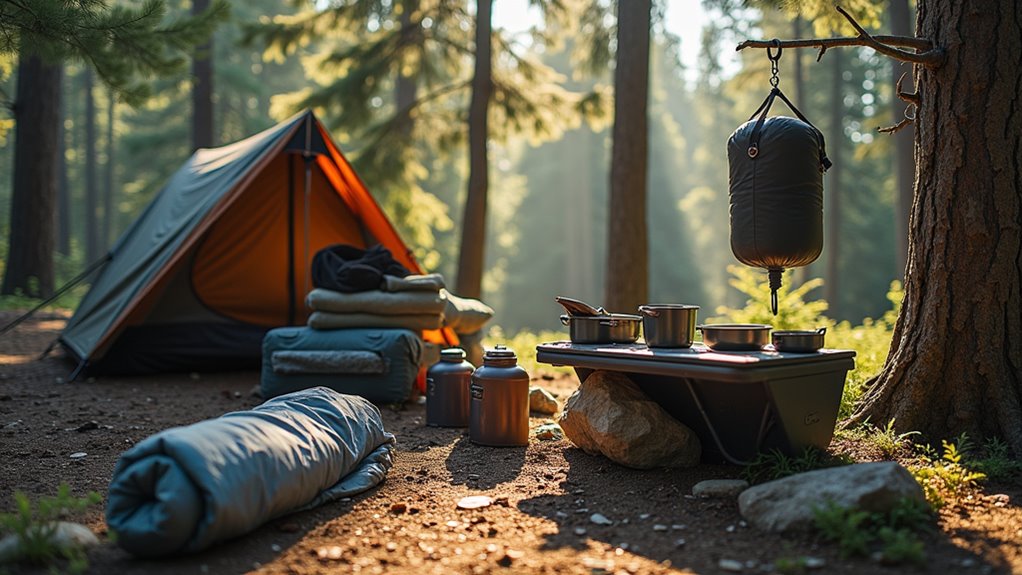
Wondering why your camping trips turn disastrous when gear gets ruined, food spoiled, or equipment fails unexpectedly?
You’ve likely experienced that sinking feeling when you discover your sleeping bag is soaked, your food has attracted unwanted wildlife, or your electronics have stopped working after a damp night outdoors. Proper camping storage isn’t just about organization—it’s about protecting your investment and ensuring your safety in the wilderness. The difference between a successful camping trip and a disaster often comes down to how well you’ve stored and protected your essential gear.
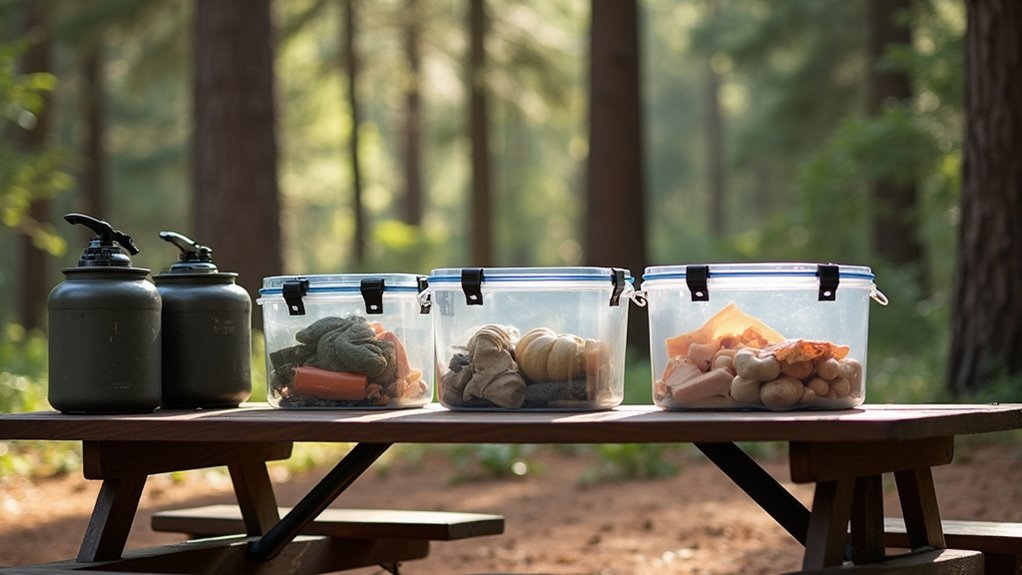
When you’re miles from civilization and storm clouds roll in, your gear’s survival depends entirely on the storage containers you’ve chosen. Hard-shell coolers with rubber gaskets protect food and electronics from moisture while maintaining seal integrity under pressure.
Waterproof dry bags in various sizes keep clothing, sleeping bags, and documents bone-dry during downpours or river crossings.
Plastic storage bins with locking lids offer versatile organization for camp kitchen supplies and tools. Choose containers with O-ring seals rather than basic snap-on lids—they’ll withstand temperature fluctuations and impact better.
Metal ammo cans provide bombproof protection for fire-starting materials and first aid supplies.
Test every container’s seal before departure by submerging it underwater. If bubbles appear, find a replacement. Your gear’s protection isn’t worth gambling on subpar storage.
Remember that proper storage is part of Leave No Trace principles, ensuring you can pack out all your belongings without leaving anything behind at your campsite.
Protecting your food from bears requires more than just weatherproof containers—you need specialized storage systems that’ll keep both your provisions and these powerful animals safe.
Bear canisters are your most reliable option. These hard-sided containers meet wildlife agency standards and withstand determined bears. Store them 100 yards from your campsite, never in your tent or car.
Hard-sided bear canisters meeting wildlife standards offer the most dependable protection for your food and camping safety.
If canisters aren’t available, use proper bear hang techniques. Suspend food at least 12 feet high and 4 feet from tree trunks using paracord. Choose sturdy branches that won’t support a bear’s weight.
Some campgrounds provide bear lockers—metal boxes designed specifically for food storage. Always check local regulations, as requirements vary by location.
Never leave scented items like toiletries, garbage, or cooking gear unsecured.
Many camping enthusiasts combine food storage planning with other outdoor activities like rock climbing to maximize their wilderness experience.
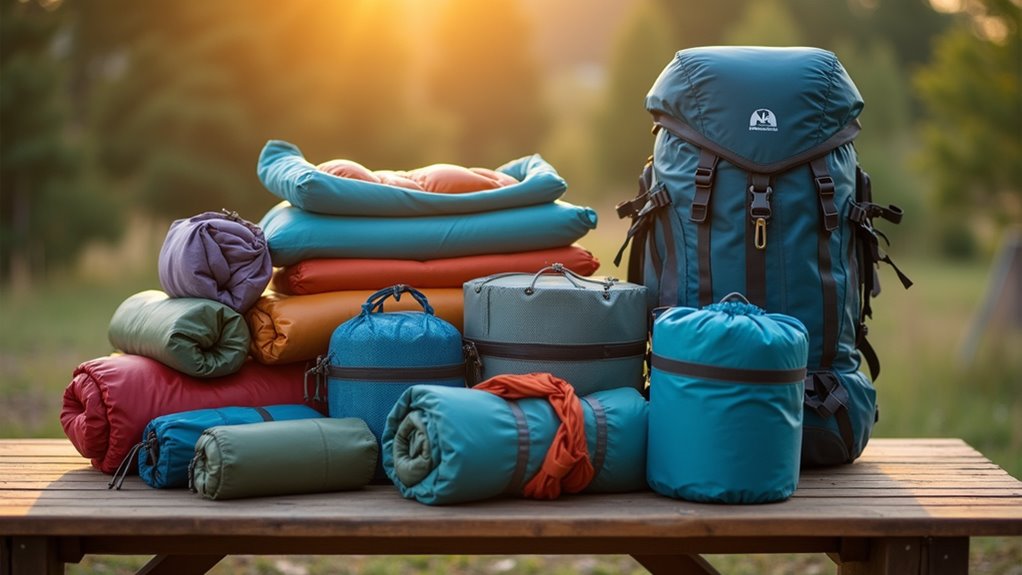
Since you’ll carry everything on your back or stuff it into your vehicle, smart packing strategies can make the difference between a smooth adventure and a frustrating scramble for misplaced gear.
Use clear storage containers or packing cubes to group similar items together—cooking supplies in one, first aid in another. Label everything so you won’t dig through multiple bags in the dark.
Pack heavy items close to your back in backpacks, and distribute weight evenly in vehicles.
Create a gear checklist and stick to it. Pack items you’ll need first on top or in easily accessible pockets.
Roll clothes instead of folding to save space. Keep frequently used items like headlamps, maps, and snacks within arm’s reach.
For those planning caravan camping adventures, these storage principles become even more critical as you’ll have designated spaces for gear throughout your mobile basecamp.
Your carefully organized gear won’t do you any good if moisture, dust, or impact damage destroys your electronics and sensitive equipment in the backcountry. Waterproof cases and dry bags are your first line of defense against rain and humidity. Pelican cases offer maximum protection for cameras and GPS units, while lighter options like dry sacks work well for phones and batteries.
Pack electronics in the center of your backpack, surrounded by soft items like clothing. Remove batteries from devices you won’t use daily to prevent corrosion. Store spare batteries in separate waterproof containers. Silica gel packets absorb moisture inside cases.
For extreme conditions, consider vacuum-sealed bags as an additional barrier. Always carry backup power sources and protective lens caps. These protection strategies become even more critical during winter RV camping when cold temperatures and moisture can cause additional damage to sensitive electronic components.
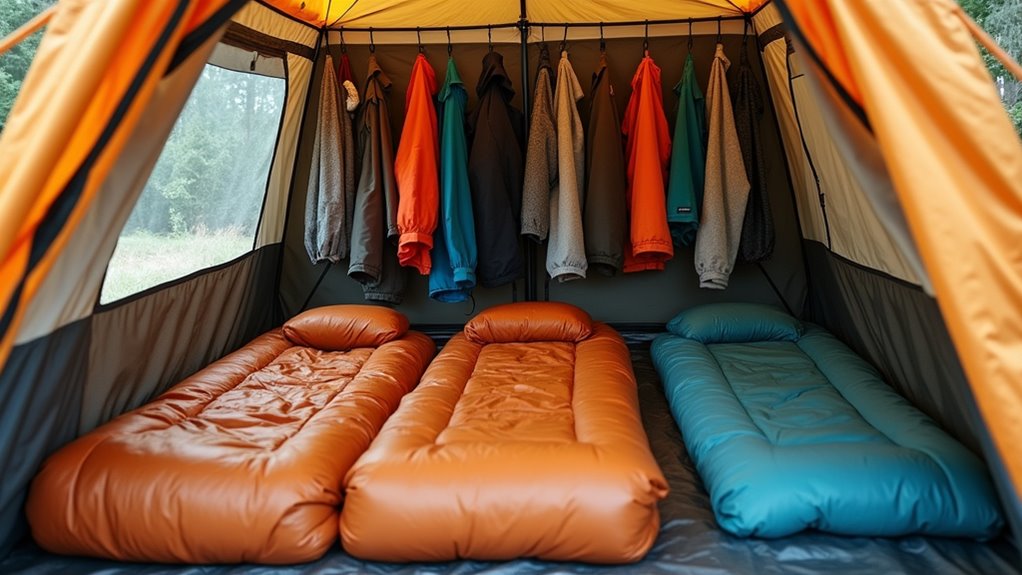
While electronics require rigid protection, clothing and sleeping gear demand a different storage approach that balances compression, accessibility, and fabric care.
You’ll want compression sacks for bulky items like sleeping bags and puffy jackets—they’ll save precious pack space while maintaining loft recovery. Roll your clothes instead of folding them to prevent creases and maximize efficiency. Store dirty clothes in mesh laundry bags to separate them from clean items and allow airflow.
Keep extra socks and underwear in waterproof stuff sacks since they’re essential backup items. Don’t over-compress down insulation for extended periods—it’ll lose its warming properties. Use packing cubes to organize different clothing categories, making morning routines faster.
Always pack a complete change of clothes in a separate waterproof bag as your emergency backup system. When planning for low impact camping, choose storage solutions made from durable, reusable materials to minimize waste and environmental footprint.
Car camping transforms your vehicle into a mobile basecamp, giving you the luxury of bringing more gear without worrying about every ounce. You’ll want to maximize every inch of available space through strategic organization.
Use your trunk or cargo area as your primary storage zone. Pack heavy items like coolers and water containers on the bottom, closest to the axle. Store frequently accessed items like snacks and first aid kits within arm’s reach of your seating area.
Utilize door pockets, seat-back organizers, and overhead compartments for smaller essentials. Roof boxes and cargo carriers expand capacity for bulky items like tents and sleeping bags.
Keep a detailed packing list and designate specific zones for different gear categories—cooking supplies, clothing, tools, and emergency items—so you’ll always know where everything’s located. Don’t forget to allocate space for hygiene essentials like camping showers to maintain cleanliness during your outdoor adventures.

When every ounce counts on the trail, backpacking storage becomes a precise art of weight distribution and accessibility. You’ll need to maximize every cubic inch while keeping frequently used items within reach.
Your ultralight storage system should prioritize these essentials:
Pack heavy items close to your back and between shoulder blades for best balance. Store your sleeping bag at the bottom, food in bear-proof containers mid-pack, and rain gear at the top for quick deployment.
For those transitioning from backpacking to vehicle-based adventures, consider attending Britain’s Motorhome Show to explore storage solutions for larger camping setups.
After months of backcountry adventures, your storage gear accumulates dirt, moisture, and odors that can compromise both performance and longevity. Clean your packs with mild soap and lukewarm water, scrubbing gently with a soft brush to remove stubborn grime. Don’t machine wash technical fabrics – they’ll lose their water-resistant coatings.
Dry everything completely before storage to prevent mold and mildew. Hang packs upside down with all zippers open, and stuff socks or newspaper inside to maintain shape while air circulates.
Inspect zippers regularly, lubricating them with specialized zipper wax or bar soap. Check seams for loose threads and waterproof coatings for wear.
Store gear in cool, dry places away from direct sunlight, which degrades fabrics over time. Properly maintained storage equipment becomes one of the essential items that ensures your next camping adventure runs smoothly from start to finish.
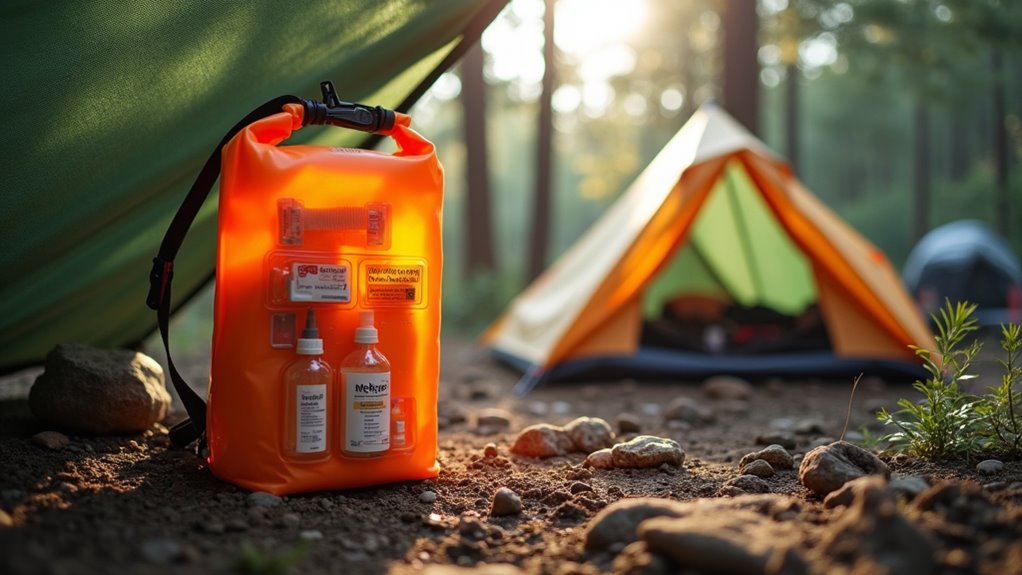
Because emergencies don’t wait for convenient timing, you’ll want your first aid supplies organized for instant access and maximum effectiveness. Store your kit in a waterproof, hard-case container that’s clearly marked and easily identifiable in low light conditions.
Keep your emergency kit organized with these essential practices:
You’ll also want to designate one person as the “kit keeper” who’s responsible for regular checks and restocking supplies. Plus, consider having broadband connectivity available at your campsite to quickly access emergency services or communicate your location if serious medical situations arise.
While first aid kits require immediate access, your seasonal camping gear needs a different storage approach focused on preservation and longevity.
Clean and thoroughly dry all equipment before storing to prevent mold, mildew, and corrosion. Store sleeping bags loosely in breathable cotton sacks rather than compressed stuff sacks to maintain loft.
Proper cleaning and loose storage in breathable materials prevents equipment damage and preserves sleeping bag insulation for years.
Hang tents or lay them flat in dry areas, ensuring zippers are partially open for air circulation. Apply protective treatments to leather boots and metal components.
Use moisture-absorbing packets in storage containers, especially for electronics and metal gear. Inspect stored items quarterly, rotating gear to prevent permanent creases.
Label everything with storage dates and condition notes. Keep seasonal items in climate-controlled spaces when possible, avoiding basements, attics, or garages with temperature extremes.
Whether you’re planning backpacking adventures across the UK or local weekend trips, proper gear storage ensures your equipment remains ready for your next outdoor excursion.
You’ll transform your camping experience when you implement these storage strategies. Take Sarah’s three-week backcountry trip through Yellowstone—she used vacuum-sealed bags for clothing, bear canisters for food, and waterproof electronics cases. While other campers dealt with soggy gear and wildlife encounters, she stayed organized and safe throughout her journey. Start with one storage upgrade per trip, and you’ll quickly build a system that keeps your adventures smooth and stress-free.